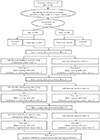1. Kitajima Y, Nakamura M, Maeda J, Kanai-Pak M, Aida K, Huang Z, et al. Robotics as a tool in fundamental nursing education. In : Duffy VG, editor. Digital human modeling Applications in health, safety, ergonomics and risk management. Cham, CH: Springer International Publishing;2014. p. 392–402.
2. Suwan N, Kasatpibal N, Sawasdisingha P. Effects of student-centered teaching on knowledge, practice, and satisfaction of clean techniques among second year nursing students. Singapore Nurs J. 2013; 40(4):30–37.
3. Choi SH, So HS, Choi JY, Yoo SH, Yun SY, Kim MH, et al. Comparison of blended practicum combined e-learning between cooperative and individual learning on learning outcomes. J Korean Acad Soc Nurs Educ. 2014; 20(2):341–349. DOI:
10.5977/jkasne.2014.20.2.341.
5. Paik HJ. Educational evaluation of competency in nursing skills through open laboratory self-directed practice. J Korean Acad Fundam Nurs. 2004; 11(1):13–20.
6. Kim HS. A study on relationship between stress of clinical practice and clinical competency in nursing students. J Korea Community Health Nurs Acad Soc. 2002; 16(1):64–76.
7. Song S. The effect of self-evaluation method using video recording on competency in nursing skills, self-directed learning ability, problem solving ability and academic self-efficacy [master's thesis]. Seoul: Sungshin Women's University;2013.
8. Shin EJ. A study related to self-efficacy, satisfaction with practice and fundamentals of nursing practicum. J Korean Acad Fundam Nurs. 2008; 15(3):380–386.
9. Jho MY. Effects of core fundamental nursing skills education on self-efficacy, clinical competence and practice satisfaction in nursing students. J Korean Acad Fundam Nurs. 2014; 21(3):292–301.
10. Cheon EY. The effects of video-aided peer feedback on enhancing nursing students' understanding of foley catheterization. J Korean Acad Soc Nurs Educ. 2013; 19(1):43–51. DOI:
10.5977/jkasne.2013.19.1.43.
11. Cardoso AF, Moreli L, Braga FT, Vasques CI, Santos CB, Carvalho EC. Effect of a video on developing skills in undergraduate nursing students for the management of totally implantable central venous access ports. Nurse Educ Today. 2012; 32(6):709–713. DOI:
10.1016/j.nedt.2011.09.012.
12. Bashir GMM, Rahaman A, Galib SM, Rahaman MM. Smart phone based social networking for teaching & learning. Int J Comput Sci Mob Comput. 2014; 3(4):151–155.
13. Park HG. A study on the smart learning service for smart phone [master's thesis]. Seoul: Konkuk University;2011.
14. Kim YH. Satisfaction with evaluation method for fundamental nursing practical skill education through cell phone animation self-monitoring and feedback: Focus on foley catheterization. J Korean Acad Fundam Nurs. 2008; 15(2):134–142.
15. Yeun EJ. Effectiveness of video-record method on fundamental nursing skill education: Focused on intramuscular injection practice. J Korean Acad Soc Nurs Educ. 1999; 5(1):86–96.
16. Ji YR, Chung HM. Effects of case-based learning on task achievement and learning satisfaction in the university class. J Learner Cent Curriculum Instr. 2014; 14(9):243–265.
17. Park WW, Ko SK. Procedures and methods of multilevel analysis: With a focus on WABA. Seoul J Bus. 2005; 39(1):59–90.
18. McKenny K. Using an online video to teach nursing skills. Teach Learn Nurs. 2011; 6(4):172–175. DOI:
10.1016/j.teln.2011.04.003.
19. Farquharson AL, Cresswell AC, Beard JD, Chan P. Randomized trial of the effect of video feedback on the acquisition of surgical skills. Br J Surg. 2013; 100(11):1448–1453. DOI:
10.1002/bjs.9237.
20. Yoo MS, Son YJ, Kim YS, Park JH. Video-based self-assessment: Implementation and evaluation in an undergraduate nursing course. Nurse Educ Today. 2009; 29(6):585–589. DOI:
10.1016/j.nedt.2008.12.008.
21. Grant JS, Moss J, Epps C, Watts P. Using video-facilitated feedback to improve student performance following high-fidelity simulation. Clin Simul Nurs. 2010; 6(5):e177–e184. DOI:
10.1016/j.ecns.2009.09.001.
22. Park IH, Shin S. The effects of video-based peer assisted learning in standardized patients simulation: Pre and post operative care. Korean J Adult Nurs. 2015; 27(1):73–82. DOI:
10.7475/kjan.2015.27.1.73.
23. Kang KS. Effectiveness of video-record method on fundamental nursing skill education: Focused on enema. J Korean Acad Fundam Nurs. 1996; 3(2):273–283.
24. Hong SH, Kwon YS. Nursing student's practice scores, confidence and satisfaction in fundamentals of nursing according to teaching method for self-directed practice. Keimyung J Nurs Sci. 2010; 14(1):1–10.
25. Kim YH. Nursing students' performance and confidence in basic nursing skills after the completion of clinical practice: Focused on basic nursing skills of low performance [master's thesis]. Daegu: Keimyung University;2002.
26. Bowden T, Rowlands A, Buckwell M, Abbott S. Web-based video and feedback in the teaching of cardiopulmonary resuscitation. Nurse Educ Today. 2012; 32(4):443–447. DOI:
10.1016/j.nedt.2011.04.003.
27. Eröz-Tu B. Reflective feedback sessions using video recordings. ELT J. 2012; 67(2):175–183. DOI:
10.1093/elt/ccs081.
28. Ryoo EN, Park YS, Ha EH. Outcomes and satisfaction of simulationbased learning in nursing of patient with UGI bleeding. Korea Acad Ind Coop Soc. 2013; 14(3):1274–1282. DOI:
10.5762/KAIS.2013.14.3.1274.
29. Han KS, Park EH, Cho JY. An inquiry into subjectivity of fundamental nursing practice attitude. J Korean Acad Nurs. 2000; 30(3):682–693.
30. Shen W. Using video recording system to improve student performance in high-fidelity simulation. In : Li S, Jin Q, Jiang X, Park JJ, editors. Frontier and future development of information technology in medicine and education. Dordrecht, NL: Springer Netherlands;2013. p. 1753–1757.






 PDF
PDF ePub
ePub Citation
Citation Print
Print




 XML Download
XML Download